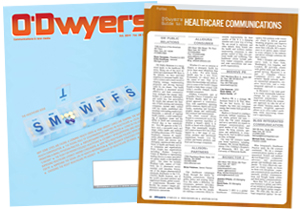 In our industry, we like to believe that we’re focused on the needs of the patient. We bring innovation to products and treatments to better their lives, and we do it every day.
In our industry, we like to believe that we’re focused on the needs of the patient. We bring innovation to products and treatments to better their lives, and we do it every day.
In June, hundreds of creative marketers from around the world met in Cannes, France for the inaugural Lions Health Festival. More than just an awards ceremony to commend worthy campaigns, it was also a chance to meet and learn from fellow communicators about how the way we talk to patients is changing.
And why not, since our patients are also changing?
At the conference, I had the honor of hosting a panel dedicated to emerging groups of patients that are smarter, more connected and better informed than ever before. Featuring three special guests with experience in advocacy, activism and healthcare entrepreneurialism, the discussion focused on how industry should aim to reach the “new” patient, and how we need to foster creative approaches to drive real engagement, and ultimately better patient outcomes.
Those special guests – Diem Brown, Renee Nicholas and Christian Kranich – were there more than just to teach us about being good communicators to patients, though. At some point in their lives, they’ve all experienced what it’s like to be patients of life-threatening diseases.
|
|
They, more than anyone else, recognize the importance of focusing on patients when delivering a message, and it’s because those patients are not just consumers anymore. They’re informed—so much so that we called them Very Informed Patientsand they’re educated about their illnesses. They form support groups online where they can learn what works and what doesn’t, where they can discover what to expect and where to go next.
In many ways, patients understand their own diseases better than we do, and some would argue, better than some of the healthcare providers who treat them. As healthcare communicators, we need to meet them with the information they want and packaged in a way they want to receive it.
Kranich exemplifies both sides of the situation, and as an HIV-positive patient advocate who has transitioned to the patient-relations side at AbbVie, he told us that it’s time for the industry to take a more active role, but not to underestimate the importance of building relationships as a key component to effective patient engagement.
“If you want to provide information to patients, then the patient has to believe you. This means you also have to put a lot of time and energy into trust building,” said Kranich.
The truth is, if patients aren’t getting the information they need from industry, they’ll get it elsewhere. They’ll seek it out from each other, they’ll look for it online and they’ll cut industry out of the equation. Considering the ways we’re positioned to give back to the patient community, it would be a shame if that happened.
With all that in mind, the panel discussion at Lions Health was framed with three strategic objectives: take action, engage the new patient and be daring.
Taking action, as Kranich explained, is not a spur of the moment decision, as talking to patients if we don’t understand them can be more harmful than helpful. Luckily, our industry has already put in the legwork. We’ve met with advocates and we’ve listened to the patients on social media for years. The panel highlighted how important it is to do more than listen, and to turn these learnings into real programming that will have a meaningful impact on patients’ lives.
And when it comes to their health, patients want to be able to ask questions and receive answers quickly.
Breast cancer survivor and former Director of Corporate Engagement for the LIVESTRONG Foundation Renee Nicholas added, “Patients don’t want to be talked at. We deserve to be a part of the conversation and to share our perspective, and industry should embrace that as a way of improving their offerings.”
“Most of all,” she continued, “patients want to feel like the industry understands them, that they have compassion and a desire to listen and learn what it feels like to undergo treatment.”
That’s why the third of the panel’s objectives is so important. We can’t be shy about saying what needs to be said in a creative way. We need to be daring.
Our industry works under some of the tightest regulations of any other marketplace, but that doesn’t mean we can’t be courageous and talk to patients like actual people instead of a product monograph.
Earlier this year, we conducted interviews with those responsible for social media discussions, and this above all was a conclusion shared by all of them. “Of the FDA warning letters issued to pharmaceutical companies in the social space, very few were actually related to an activity that was ‘social’ in nature,” says Stacey Bernstein, Senior Vice President and Director of U.S. Digital Health at Weber Shandwick.
Perhaps Diem Brown, two-time survivor of ovarian cancer and cast member for MTV, worded it best. “We’ve heard about the engaged patient for years – where is the engaged industry?”
We need to make the changes necessary to bridge the gap between patient and pharma to better our service offerings, of course, but also to rebuild and solidify our bonds with patients like her.
With these philosophies in mind, the engaged industry is only a shift in strategy away.
Peter Matheson Gay is Creative Director of Weber Shandwick's healthcare group.



 Lo Isidro, senior director at Real Chemistry with more than a decade of strategic communications and PA experience, has joined Narrative Strategies.
Lo Isidro, senior director at Real Chemistry with more than a decade of strategic communications and PA experience, has joined Narrative Strategies. Nelson Fernandez, former North American chair of APCO Worldwide and managing director of Burson-Marsteller, has joined Volunteers in Medicine Berkshires as director of communications and PA.
Nelson Fernandez, former North American chair of APCO Worldwide and managing director of Burson-Marsteller, has joined Volunteers in Medicine Berkshires as director of communications and PA. Lilit Bargar, who was most recently an EVP in the healthcare practice at Weber Shandwick, comes on board at GCI Health as EVP, corporate practice lead.
Lilit Bargar, who was most recently an EVP in the healthcare practice at Weber Shandwick, comes on board at GCI Health as EVP, corporate practice lead.
 Five ways that successful thought leaders are made.
Five ways that successful thought leaders are made.


 Have a comment? Send it to
Have a comment? Send it to 
No comments have been submitted for this story yet.